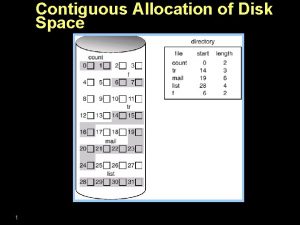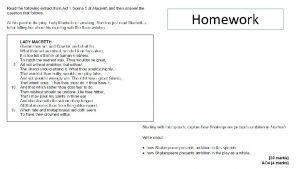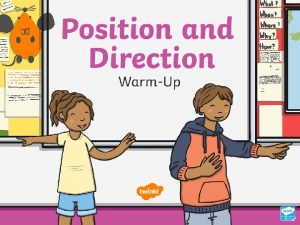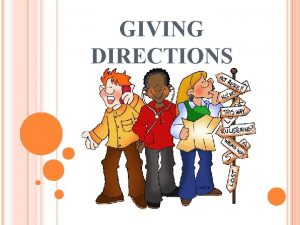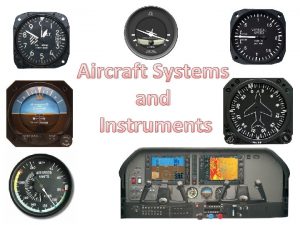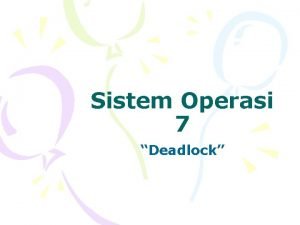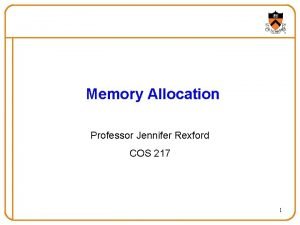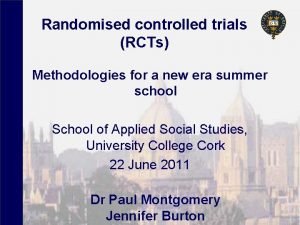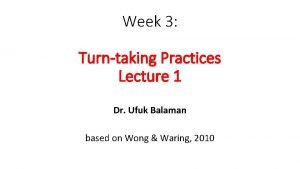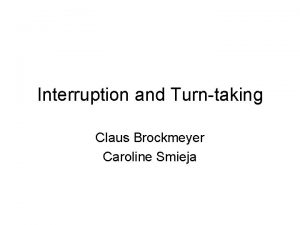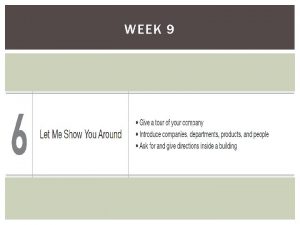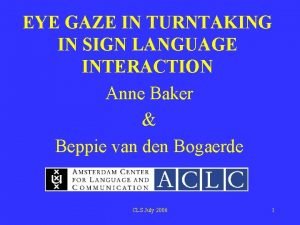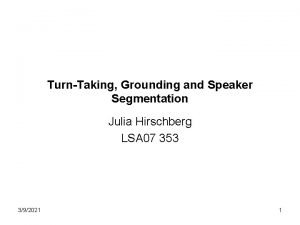Week 4 Turntaking Practices Lecture 2 Turn Allocation






















- Slides: 22

Week 4: Turn-taking Practices Lecture 2: Turn Allocation Dr. Ufuk Balaman based on Wong & Waring, 2010

• How do we figure out, then, when to start talking and when to stop? • Waiting till there is a pause can be too late for taking the turn. • In order to participate in a conversation, ESL/EFL learners can benefit from an explicit understanding of how turn allocation is managed in conversation

• When a TCU comes to a possible completion, speaker transition may become relevant (Sacks et al. , 1974) • 1. At a transition-relevance place (TRP), a set of rules apply in quick succession: (a)Current-selects-next. (b)Next speaker self-selects.

Current-Selects Next (1) address term; (2) initiating action with gaze; (3) initiating action that limits potential eligible respondents.

Address Term

INITIATING ACTION WITH GAZE • The current speaker can also select the next by using an initiating action (e. g. , a question) along with gaze, which is another form of explicit addressing (Lerner, 2003, p. 178).

INITIATING ACTION THAT LIMITS POTENTIAL ELIGIBLE RESPONDENTS • Also known as tacit addressing (Lerner, 2003)

Next-Speaker Self-Selection • Self-selection is probably the most challenging for language learners. • TASK: How do you get a turn to talk in a multi-party conversation? List three strategies you use to get the floor:

• The basic principle for next-speaker-self-selection is to “start as early as possible at the earliest transition-relevance place” (Sacks et al. , 1974, p. 719). In order to achieve this early start, a range of practices may be implemented: (1) overlap; (2) turn-entry device; (3) recycled turn beginning; (4) non verbal start.

OVERLAP • For early starters, a key question is, how early is not too early? • Three types of overlaps are considered “legitimate” or non-intrusive within the turn-taking system: 1. transitional, 2. recognitional, 3. progressional (Jefferson, 1983)

Transitional overlap • Transitional overlap is a type of overlap that orients to the syntactic completeness of an utterance and occurs near a possible completion point.

Recognitional overlap • Recognitional overlap is a type of overlap that occurs when a potential next speaker recognizes the thrust or upshot of the prior talk.

Progressional overlap • Progressional overlap is a type of overlap that orients to the forward movement/progressivity of an utterance and occurs when that utterance begins to show various types of disfluency.

TURN-ENTRY DEVICE • Turn-entry device is a turn-initial item such as well, but, and, so, you know, or yeah which does not project the exact plan of the turn’s construction. • Also known as pre-starts

RECYCLED TURN BEGINNING • Recycled turn beginning is a practice that involves repeating the part of a turn beginning that gets absorbed in overlap.

NONVERBAL START • One can also achieve early starts via a range of pre-beginning nonverbal cues such as gaze direction, head turning, facial expression, lip parting, cough or throat clearing (Schegloff, 1996, pp. 92– 93).

PREPARING FEEDBACKS FOR YOUR RECORDINGS 1. Fill out the feedback sheet 2. Watch your recordings and try to evaluate the your talk-ininteraction based on the items in the feedback sheet and the lectures/presentations. 3. Transcribe two 10 seconds-long segments (one positive + one negative) 4. Write two short paragraphs to reflect on your own talk-ininteraction (one for positive + one for negative)

HOW TO TRANSCRIBE TALK-IN-INTERACTION • Line numbers (usually a new line for each TCU ) • Labels for the interactants • Font type: Courier New • Indicating silence in seconds = (1. 2) • Indicating overlaps = [ ] • Indicating intonation = ↑ ? ↓. • Indicating cut-offs = • Indicating emphasis = underlined text


CONVERSATION WORKSHOP III

• • You want to hear a joke? Something really wonderful happened today. I have something terrible to tell you. Can I ask you a question? Can I tell you something? Can I make a suggestion? Can I ask a favor? • Is schooling important? • What do you think about the role of Internet in our daily lives? • What is the best way to learn a subject?

• • You want to hear a joke? Something really wonderful happened today. I have something terrible to tell you. Can I ask you a question? Can I tell you something? Can I make a suggestion? Can I ask a favor? • Is schooling important? • What do you think about the role of Internet in our daily lives? • What is the best way to learn a subject? CURRENT SELECTS NEXT SPEAKER SELF-SELECTS (1) address term; (2) initiating action with gaze; (3) initiating action that limits potential eligible respondents. (1) overlap; (2) turn-entry device; (3) recycled turn beginning; (4) non verbal start.
 Contiguous allocation vs linked allocation
Contiguous allocation vs linked allocation Turn construction
Turn construction Turn allocation
Turn allocation Macbeth seeing banquo's ghost quote
Macbeth seeing banquo's ghost quote One quarter turn clockwise
One quarter turn clockwise Answer. go straight turn left turn right
Answer. go straight turn left turn right Turn left
Turn left Go straight and turn left
Go straight and turn left Turn the arrow 1/4 turn clockwise
Turn the arrow 1/4 turn clockwise Turn hell hound turn
Turn hell hound turn You can't turn right here. you turn left.
You can't turn right here. you turn left. Who is macbeth's cousin
Who is macbeth's cousin Atomatoflames flaps
Atomatoflames flaps Wash your hands put on your nightgown analysis
Wash your hands put on your nightgown analysis Tv turn off week
Tv turn off week 01:640:244 lecture notes - lecture 15: plat, idah, farad
01:640:244 lecture notes - lecture 15: plat, idah, farad Week by week plans for documenting children's development
Week by week plans for documenting children's development Resource allocation graph with a deadlock
Resource allocation graph with a deadlock Heap allocation
Heap allocation First fit best fit worst fit testing
First fit best fit worst fit testing Paul montgomery cork
Paul montgomery cork Capital allocation line
Capital allocation line Resource allocation graph in os
Resource allocation graph in os
